Pastalaya is just what it sounds like, basically jambalaya with pasta instead of rice. This one-pot dish starts by building a deep flavor base of browned pork, chicken, and sausage, adding the Trinity and other South Lousiana seasonings, then adding uncooked spaghetti pasta to cook in a rich stock until the pasta has absorbed the flavorful liquid. It's no surprise that Pastalaya is very popular in South Louisana. Try this at your next family gathering, tailgate, or Mardi Gras party. Perfect for a crowd, Sweet Daddy D’s no-angst Pastalaya recipe is simple and absolutely delicious.
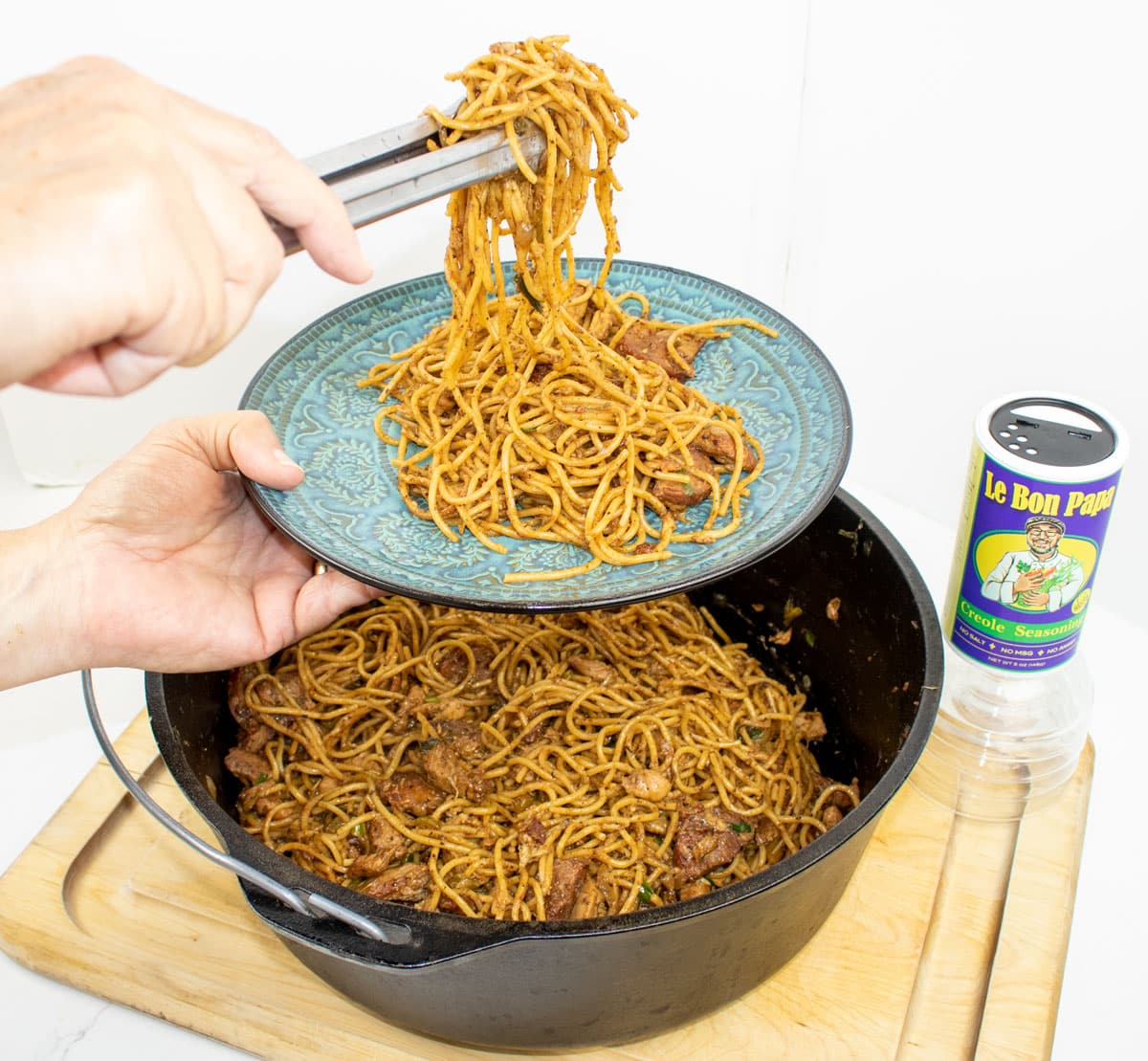
If you want to just skip to the recipe, click the "Jump To Recipe" button above or the Recipe link below and you’ll go right there without having to scroll through my article.
This post is not sponsored, but you will find affiliate links on this page. As an Amazon Associate, I earn from qualifying purchases. The price you pay as a consumer does not change, but I may make a small commission based on your purchase.
Jump to:
What is Pastalaya?
As you may guess from the name, Pastalaya is a variation of Jambalaya with pasta taking the place of rice. This is a relatively new dish in South Louisiana cuisine but has continued to gain popularity over the last fifteen or so years. Pastalaya is usually served like jambalaya is served; great for large groups, relatively low cost and is made in one pot. It's great in a small batch or can easily be scaled up for a crowd.
There isn’t much information available about the origins of Pastalaya. One story I read said that it was created by a chef starting out to make jambalaya before he realized that he didn’t have any rice. He substituted pasta and the rest was history. I’ve also read that the dish is a fusion of Italian and Creole cuisines, using pasta in place of rice. Both sound plausible, but whatever the origin, it is becoming a staple in South Louisiana.
What Makes a Good Pastalaya?
I’ve eaten a lot of Pastalaya in my life, some outstanding and some not. When it's not great it's usually because the cook treats it like a pasta dish, not taking the time to build the flavor. Another factor is choosing the wrong type of pasta. In my opinion, the best Pastalaya is built like a jambalaya, using a long noodle like spaghetti. Layers of flavor and color are built from the bottom up. Browning the meats create the fond that is mixed into the Trinity, creating a base of deep flavor and color. The flavor and color are then infused with other seasonings by slowly simmering them together in a rich stock. Uncooked pasta is added and absorbs the flavors of the simmering liquid. The end result is a harmonious flavor creation that is unlike most pasta dishes.
Here’s What You Need
Here are some of the key ingredients for this recipe:
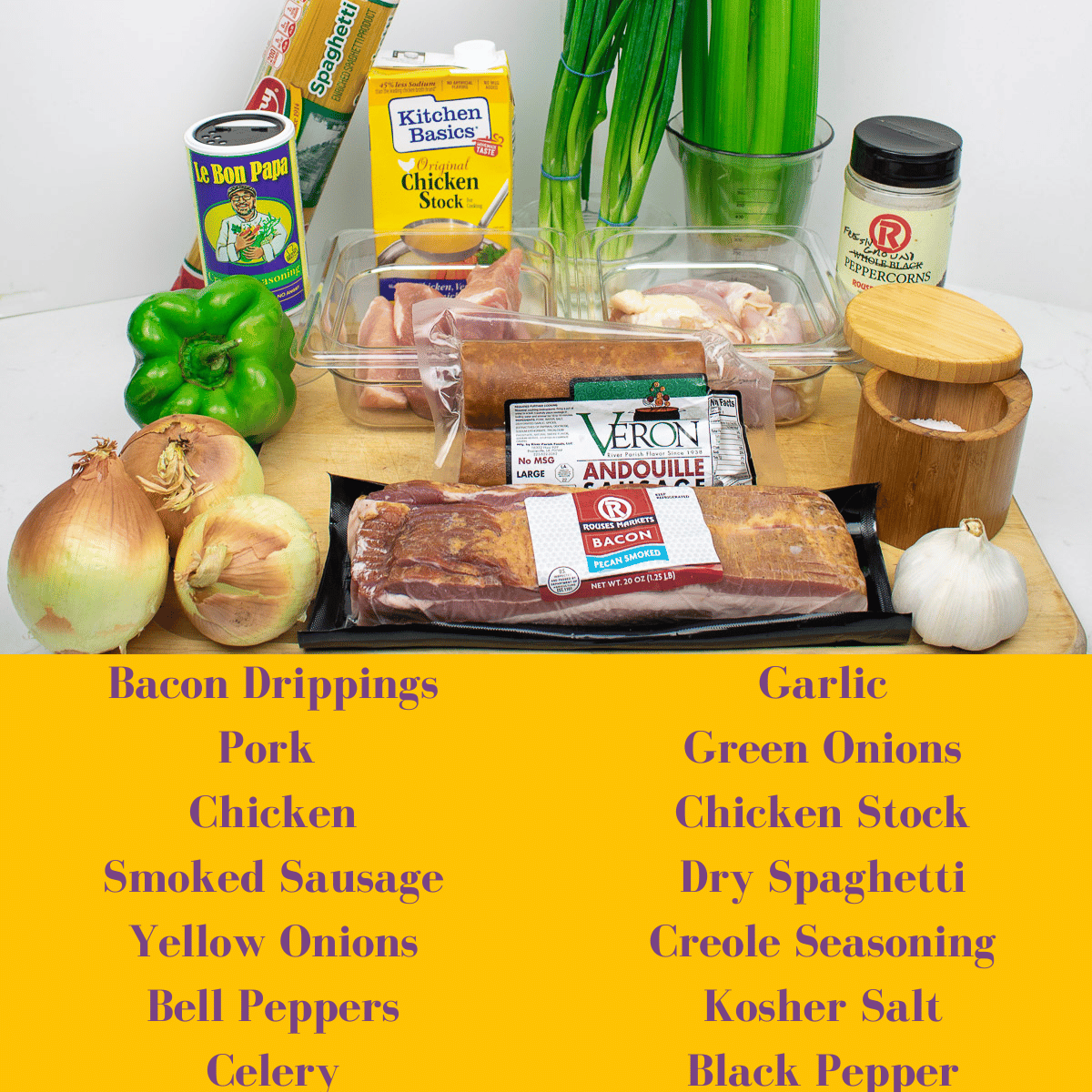
Note on the bacon drippings: If you have stored bacon drippings available, you can use them. My rule of thumb is to use 1 slice of bacon for each tablespoon of bacon drippings you need, and vice versa.
Note on the Trinity: The yellow onions, bell peppers, and celery serve the purpose of the mirepoix in French cuisine. In South Louisiana vernacular, we refer to these collectively as the Trinity or Holy Trinity.

Equipment
Here is some of the equipment I used in making this recipe:
This post is not sponsored, but you will find affiliate links on this page. As an Amazon Associate, I earn from qualifying purchases. The price you pay as a consumer does not change, but I may make a small commission based on your purchase.
Here’s What You Do
First…you have a beer. South Louisiana cuisine has so many dishes that are just fun to make. That's likely because you know you're going to have fun with friends and family when you eat them. This is one such recipe. Get prepared by sipping on a beer while you read the recipe all the way through. Makes sure you have the ingredients you need, and learn what to do with them and what equipment you will need. Then perform your mise en place and you're ready to go.
Mise en place
All should be in their own prep bowls:
- Chop the pork into bite-size ½ to ¾-inch cubes or strips; sprinkle on some Le Bon Papa Creole Seasoning and set aside.
- Do the same with the chicken.
- Slice the smoked sausage into medallions about ¼ inch thick.
- Slice the bacon into about 1-inch pieces.
- Chop the Trinity, garlic, and green onions.
- Measure the stock, pasta, and the Herbs and Spice Blend.
Pro Tip on chopping: The Trinity can be roughly chopped without much concern for the size because it will cook for a while in the stock. When making this recipe, I like to cut the pork, chicken, and green onions into somewhat long strips. I think that matches better with the spaghetti. But, the bottom line? Chop everything the way you want.
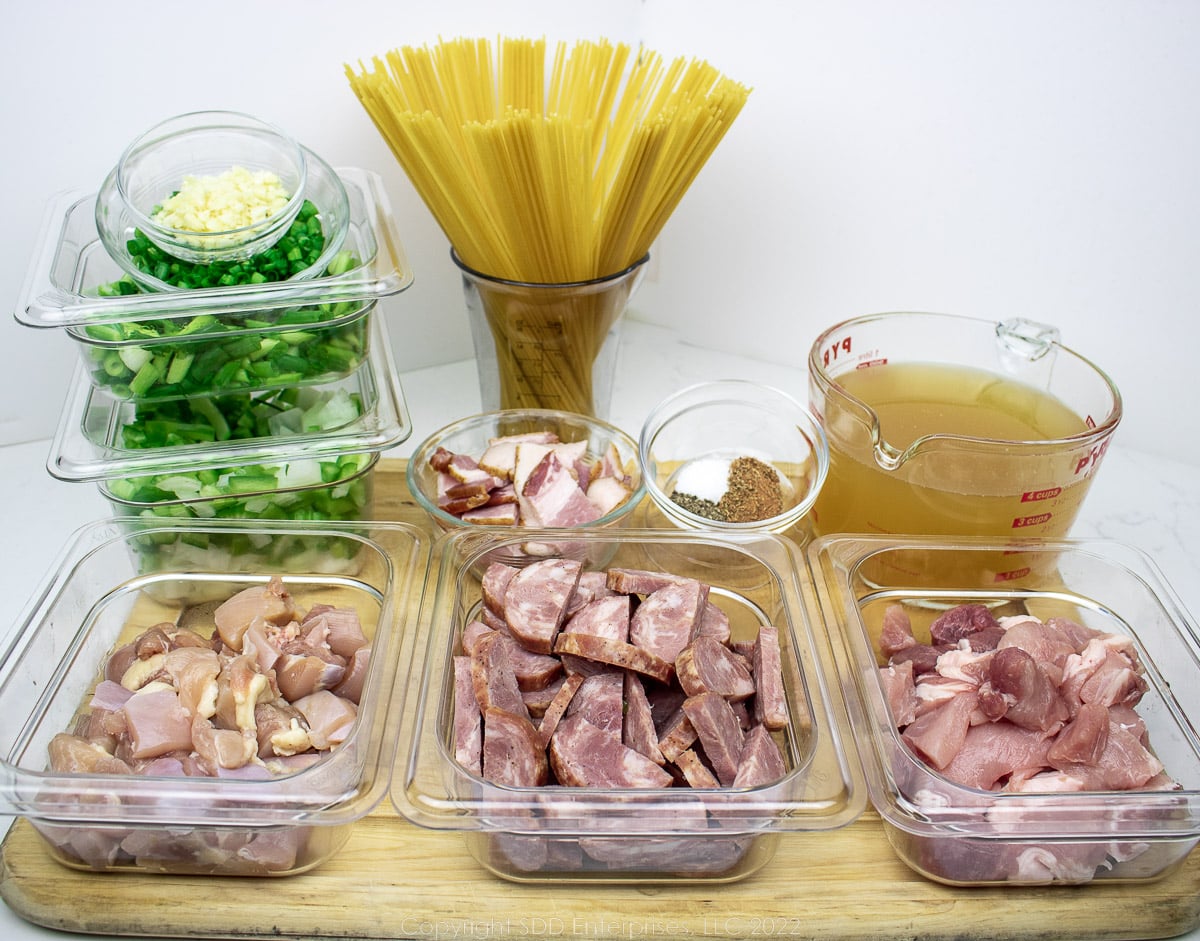
Brown the Meats
What happens in this step? This is when we create the first layer of deep flavor and establish the rich, brown color of the dish. When your finished dish is delicious, it's because of this step.
Start with a Dutch oven over medium heat. Fry the bacon until the fat has rendered, about 6 minutes. Alternately you can use bacon drippings that you have saved.
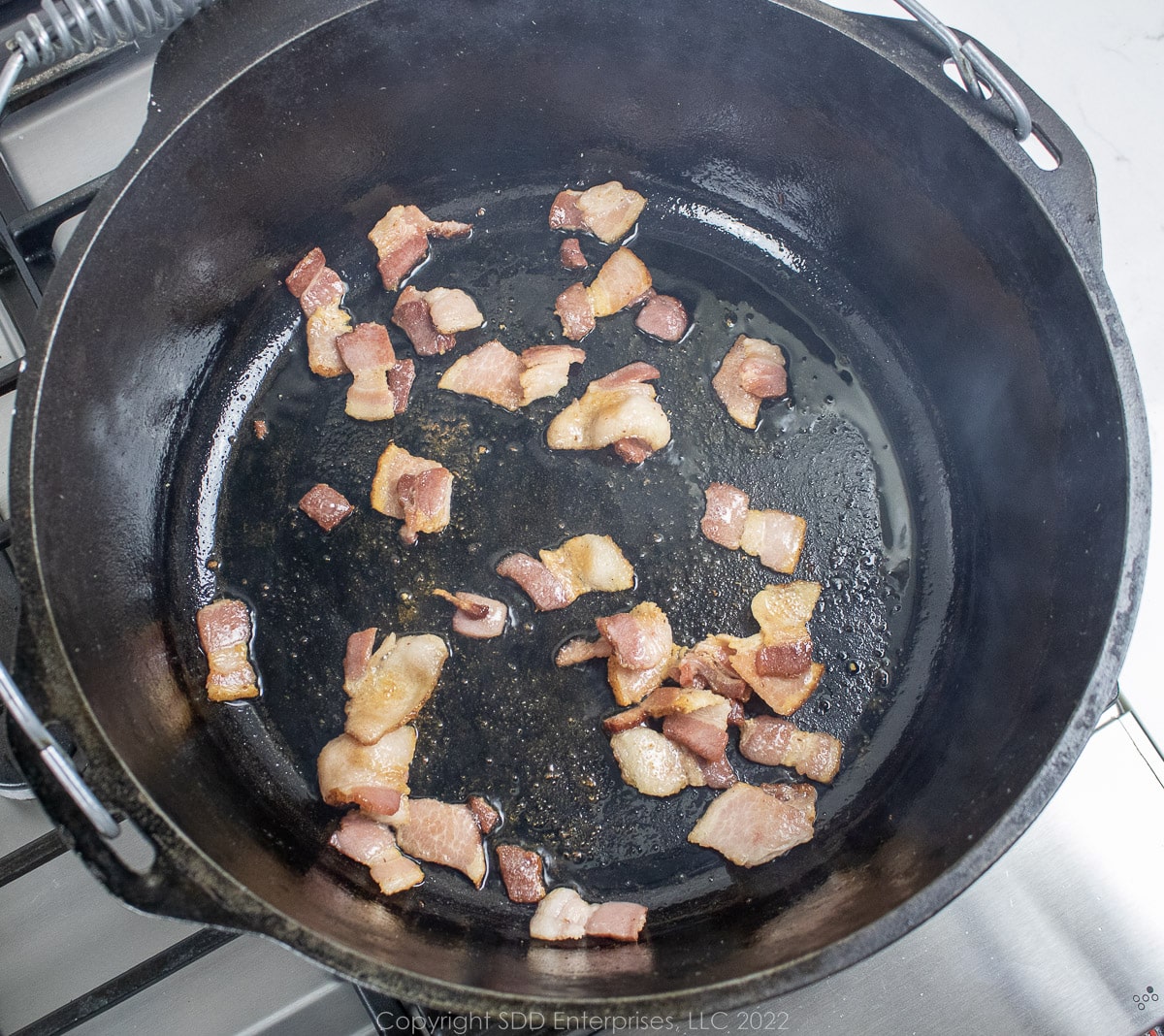
Add the seasoned pork and saute for 12 to 15 minutes until starting to brown. Stir only occasionally to make sure some searing takes place. That helps build some fond.
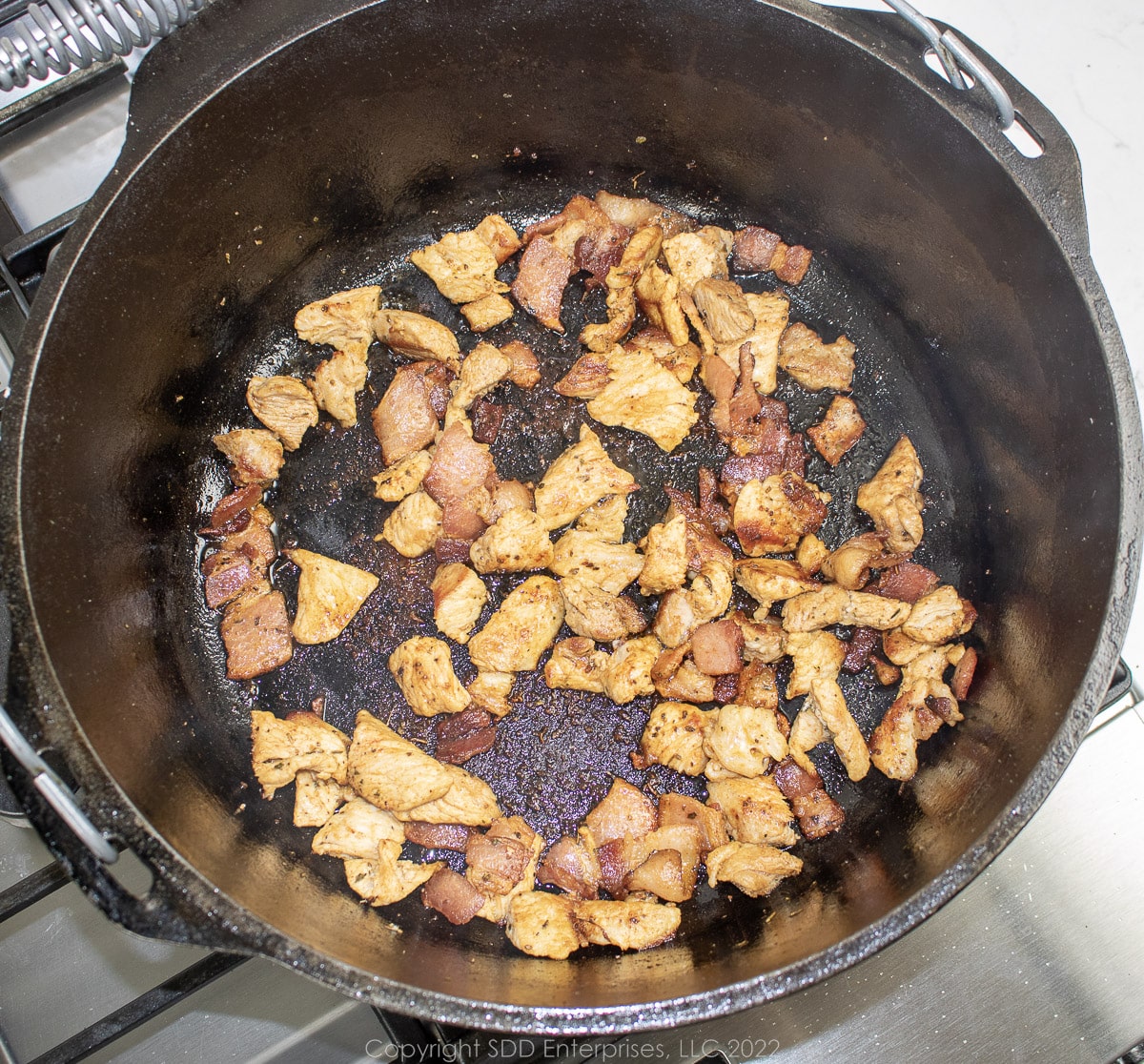
Next, add the sausage and saute for about 15 minutes until browning and rendered.
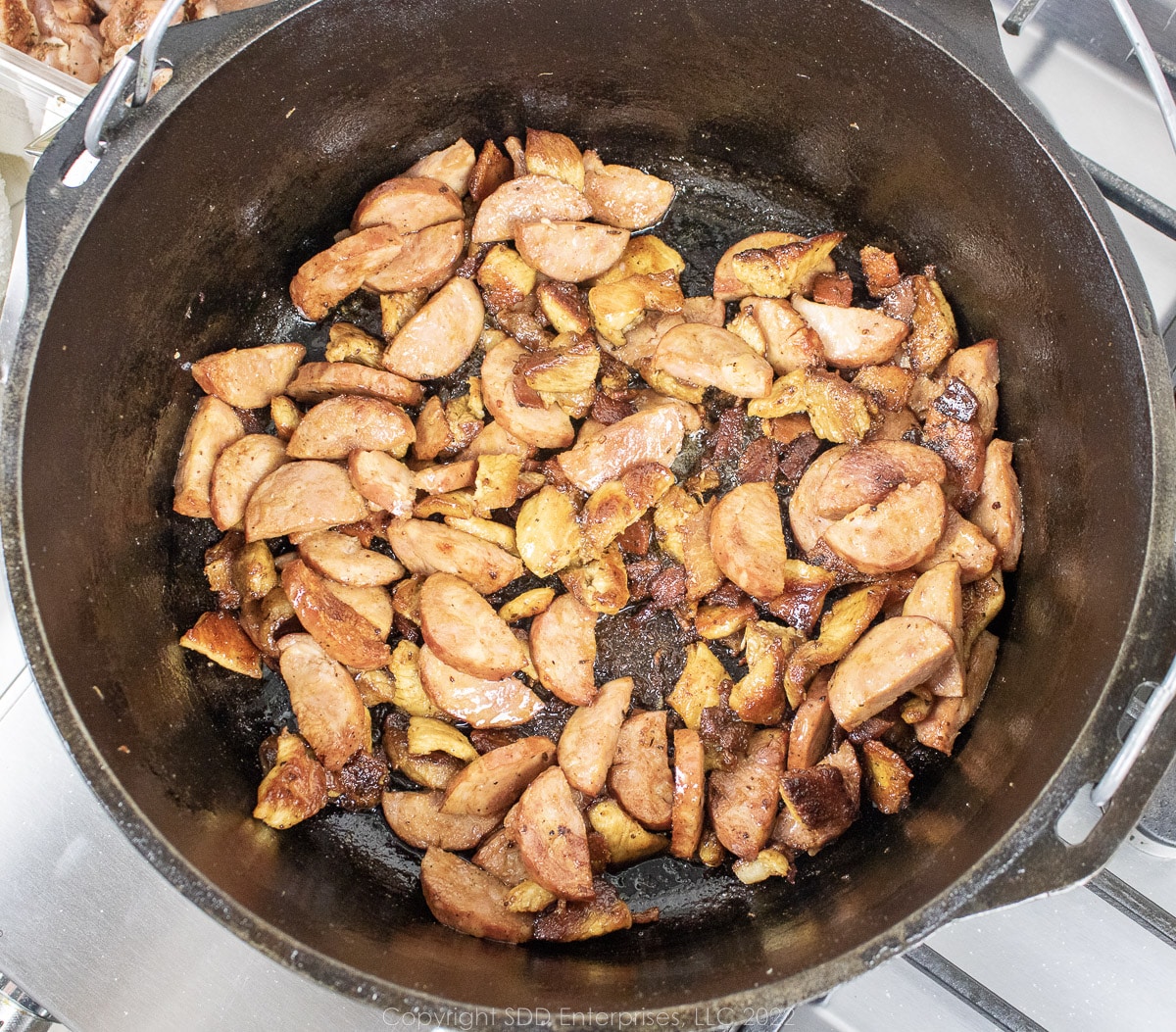
Once the sausage is browned, add the seasoned chicken and saute for about 10 minutes.
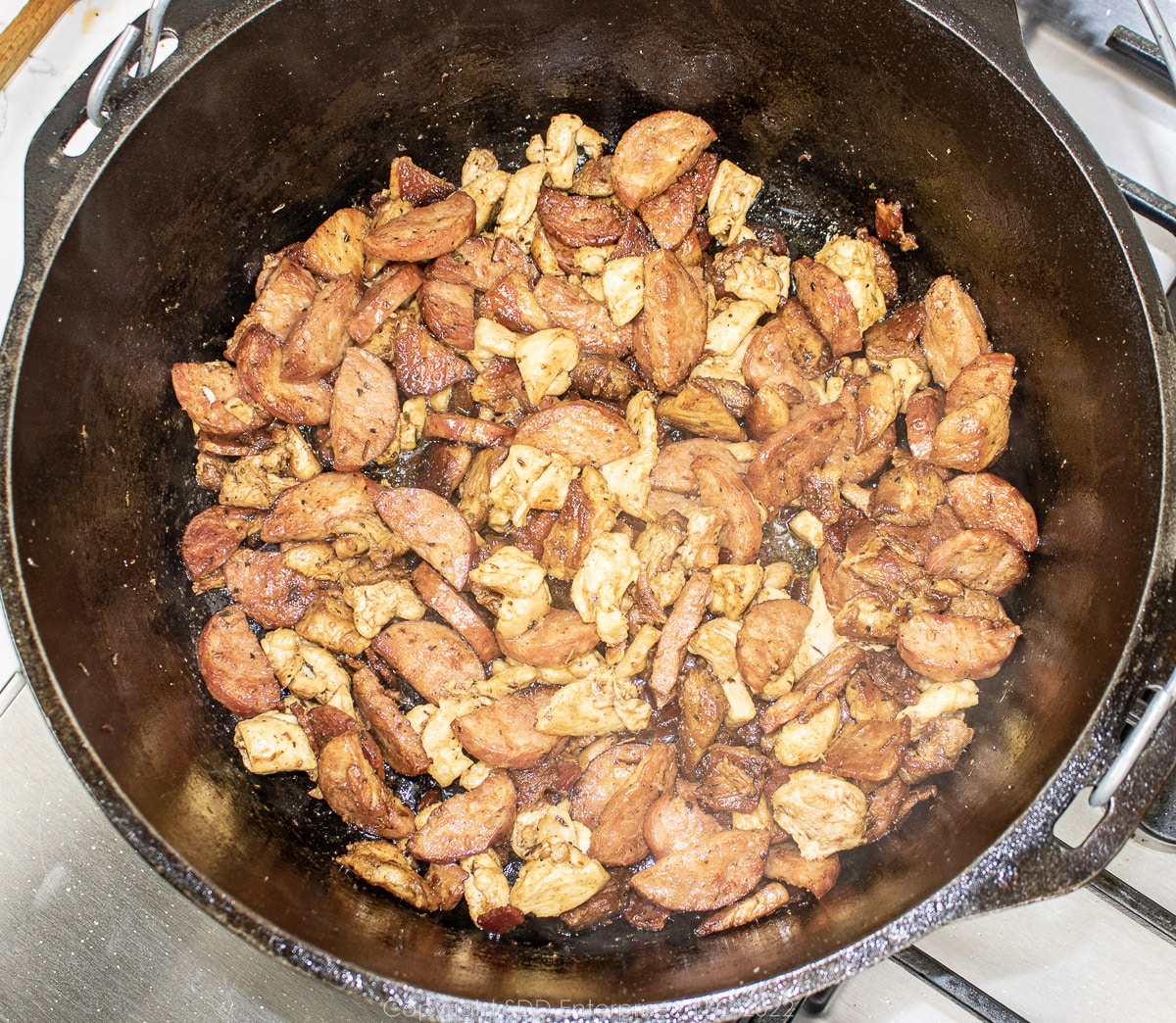
Pro Tip on browning the meat: Don’t rush through this part. Use medium heat so that the meats do not burn. Start with the fattiest meat: pork, then sausage, then chicken. Only stir occasionally because you want to get some searing that will leave fond in the pan. This fond will be picked up and mixed in, providing deep flavor and color.
Build the Stock
What happens in this step? The second step of flavor and color building comes here when sauteing the Trinity and garlic renders their natural sugars. This browns and intensifies their flavor which is then all brought together with the stock.
Increase the heat to medium-high and add the Trinity. Mix well with the browned meats and saute for about 15 minutes until the onions are starting to brown. Again, stir only occasionally, but lower the heat if it's starting to cook too fast. Don't burn the vegetables.
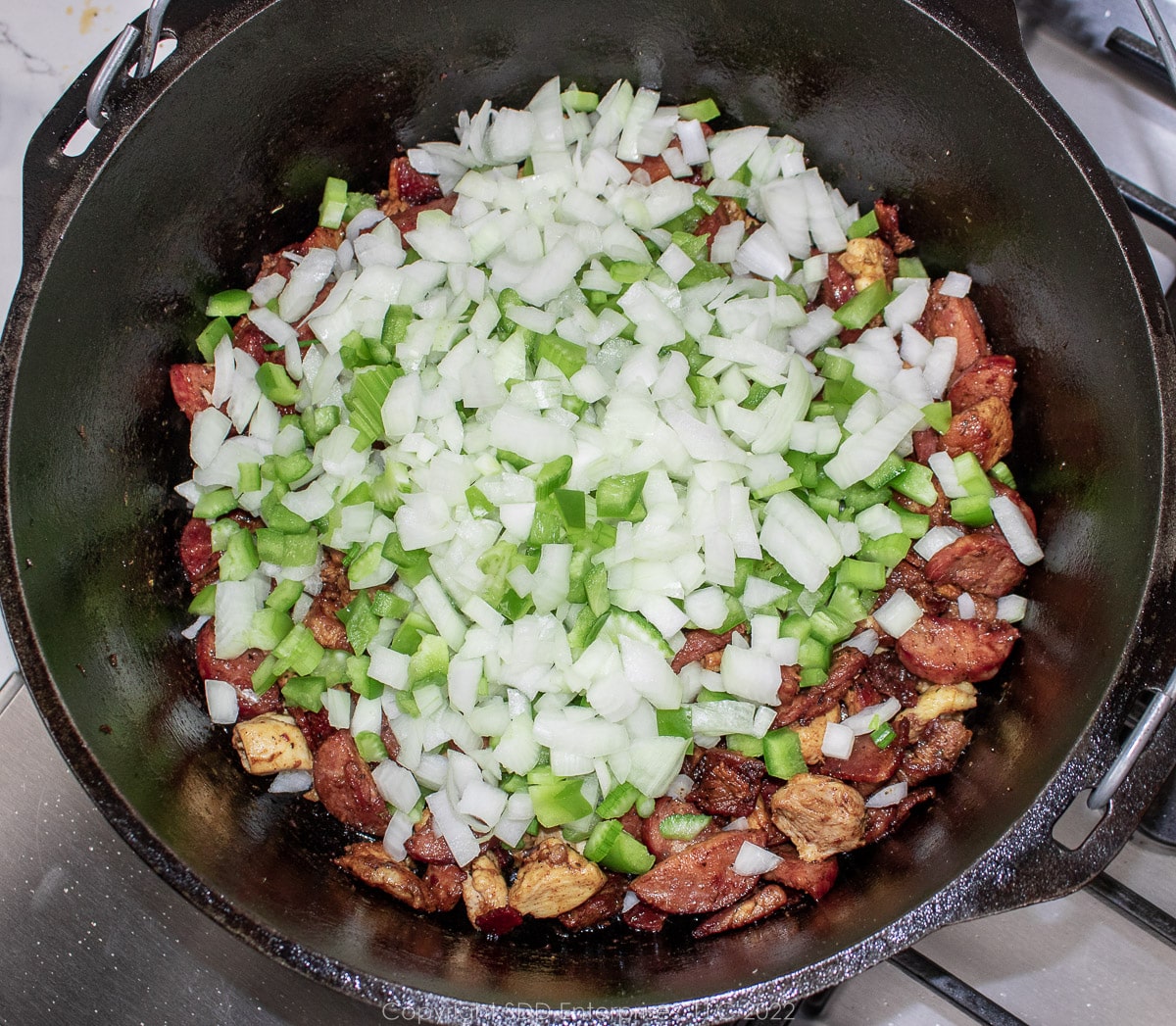
Note on the Trinity deglazing: The Dutch oven will need to be deglazed after the meats are browned, but wait until after you saute the Trinity. While frying the Trinity, the onions will sweat, releasing water that will naturally deglaze the bottom at this point.
Now, add the garlic and the Herb and Spice Blend to the Dutch oven. Mix well and saute for about 2 minutes until aromatic.
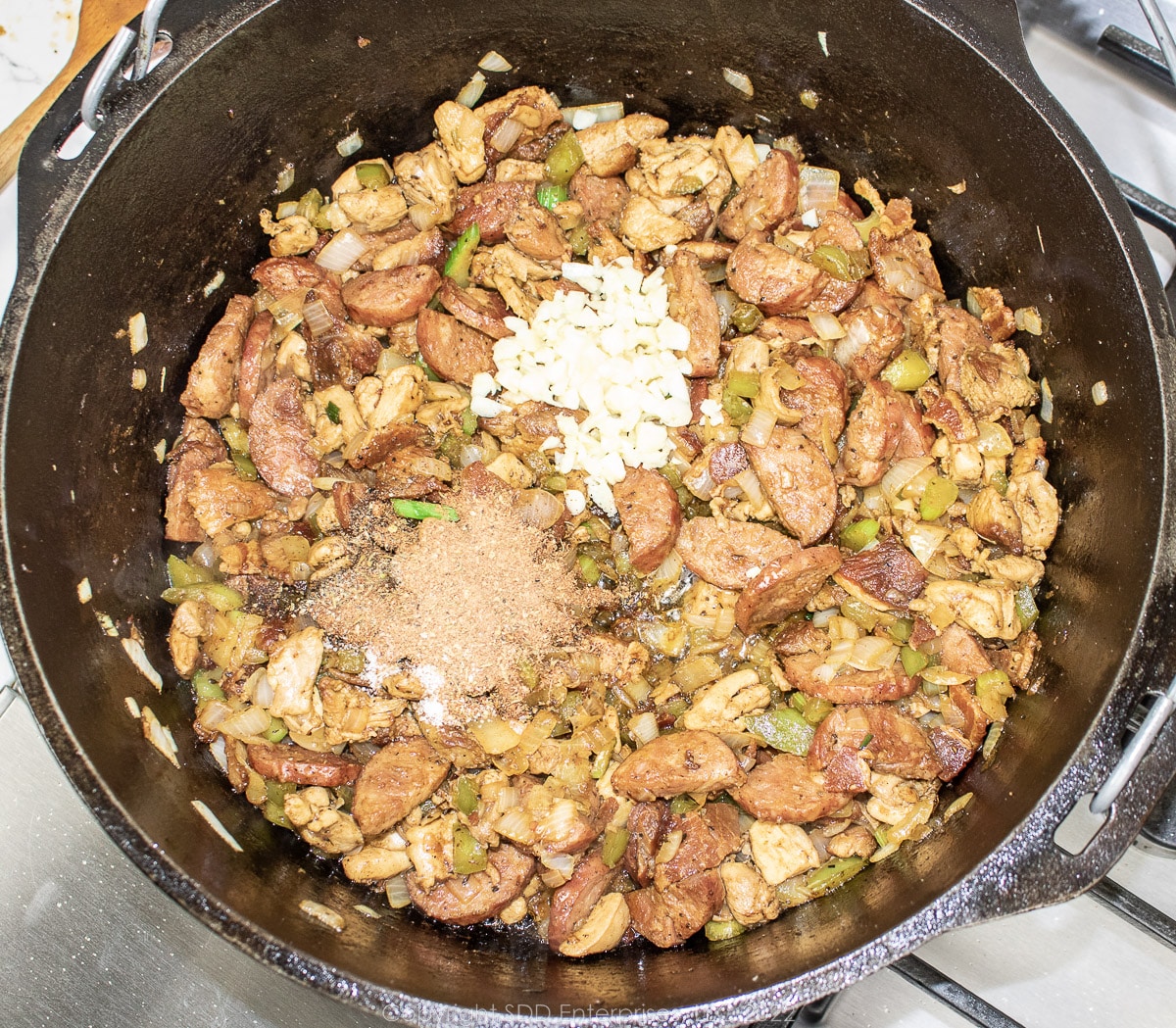
Add about ¾ of the green onions and saute another couple of minutes. Reserve the remaining green onions for later.
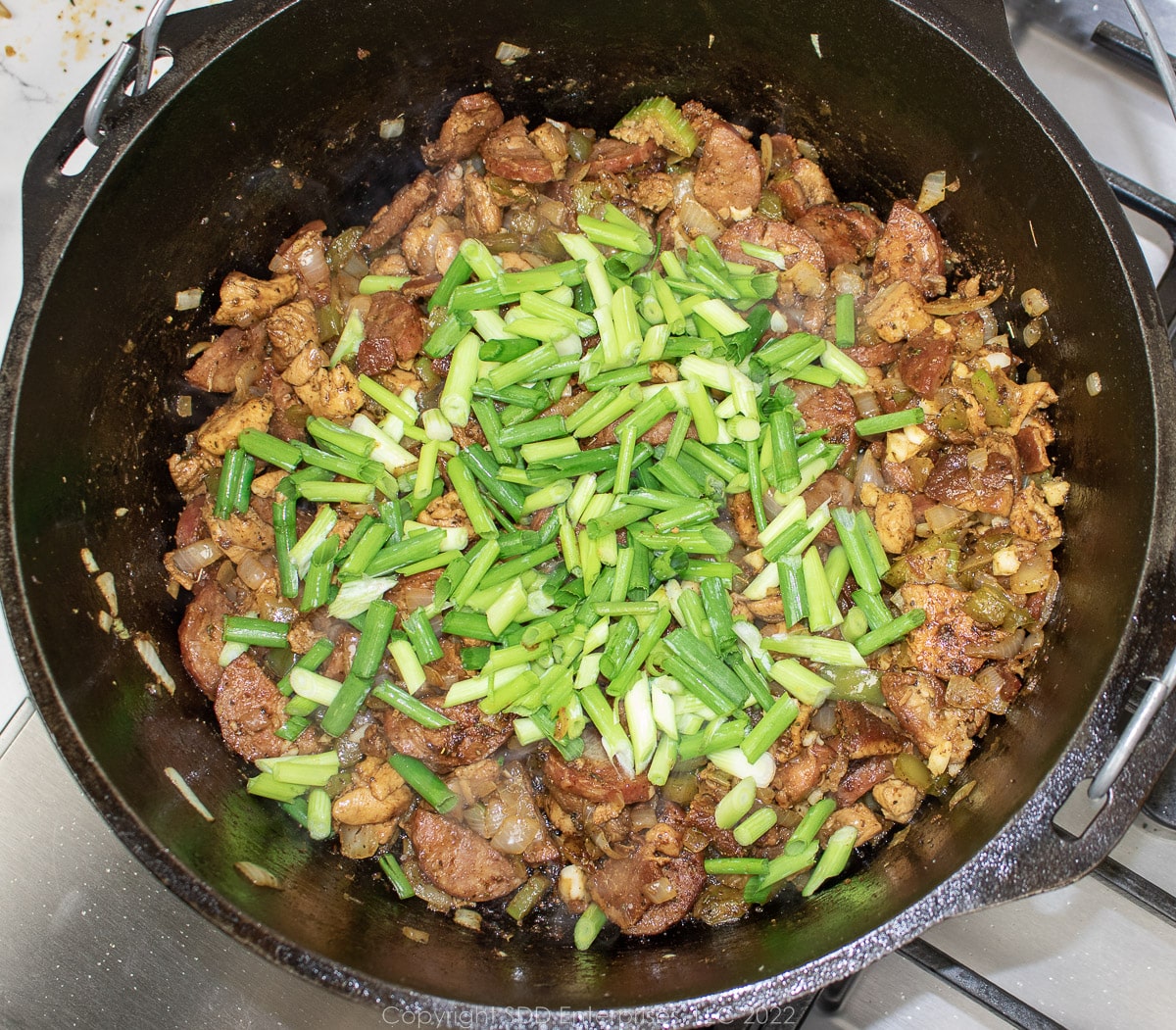
Next, comes the chicken stock. Start with about ½ cup of the stock and deglaze the fond that has built up from the vegetables. Combine the loosened fond in with the contents of the Dutch oven before adding the remaining stock. Bring the stock to a boil, then reduce the heat and simmer for 10 minutes, uncovered. As the stock simmers, taste for seasoning and make adjustments as needed. It's okay to be a little over-seasoned at this point.
Note on the pasta/liquid ratio: I use 4 cups of liquid for 1 pound of pasta. In this recipe, I added ½ cup of stock to account for the reduction that occurs while simmering the stock for 10 minutes uncovered.
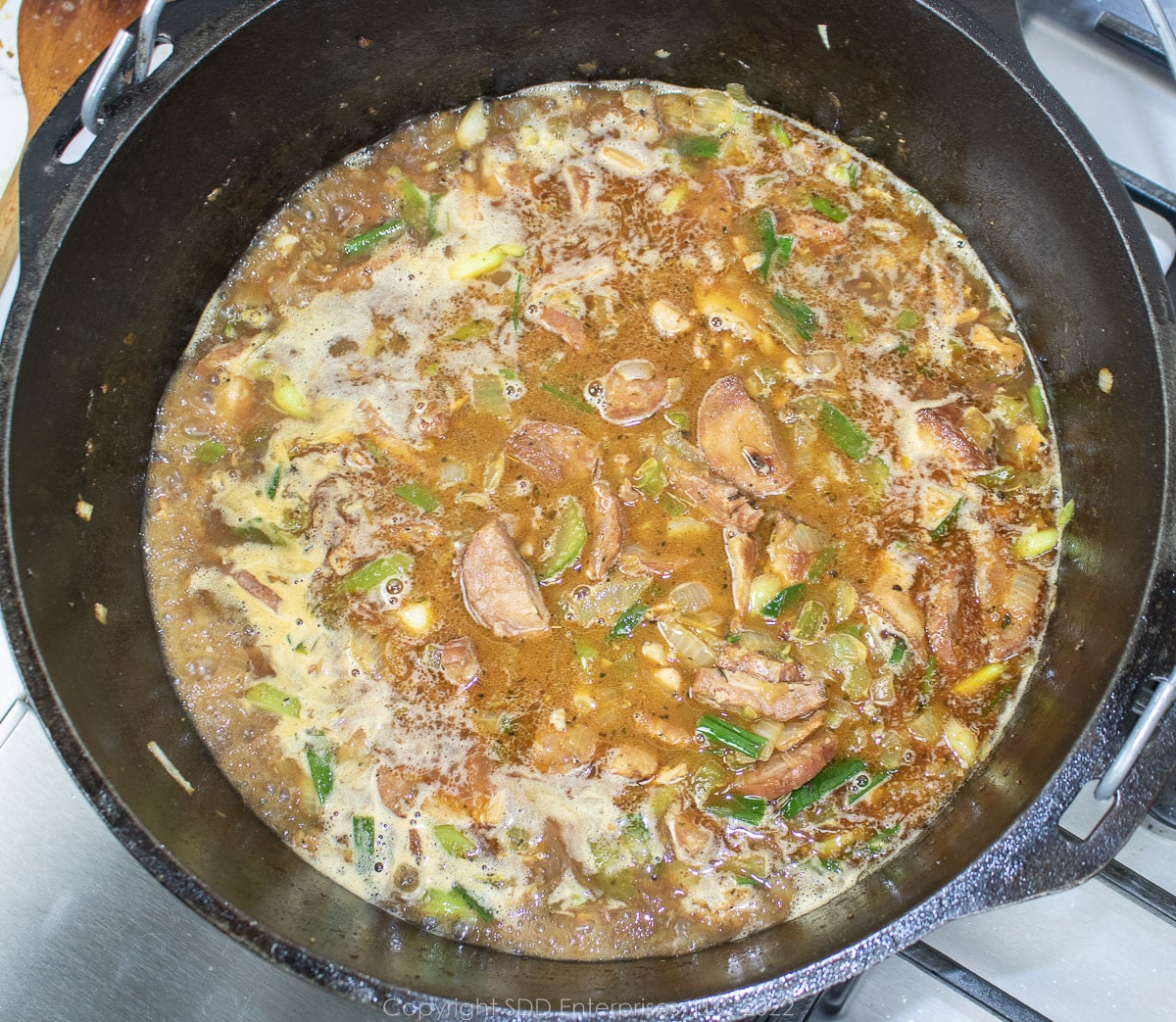
Let's Put the Pasta in Pastalaya
What happens in this step? The dry pasta will absorb the cooking stock and integrate all that great color and flavor we have been creating.
After simmering the stock for 10 minutes, increase the heat to a slight boil. Break the spaghetti in half and add it to the stock. Mix well, doing your best to coat all the pasta in the stock.
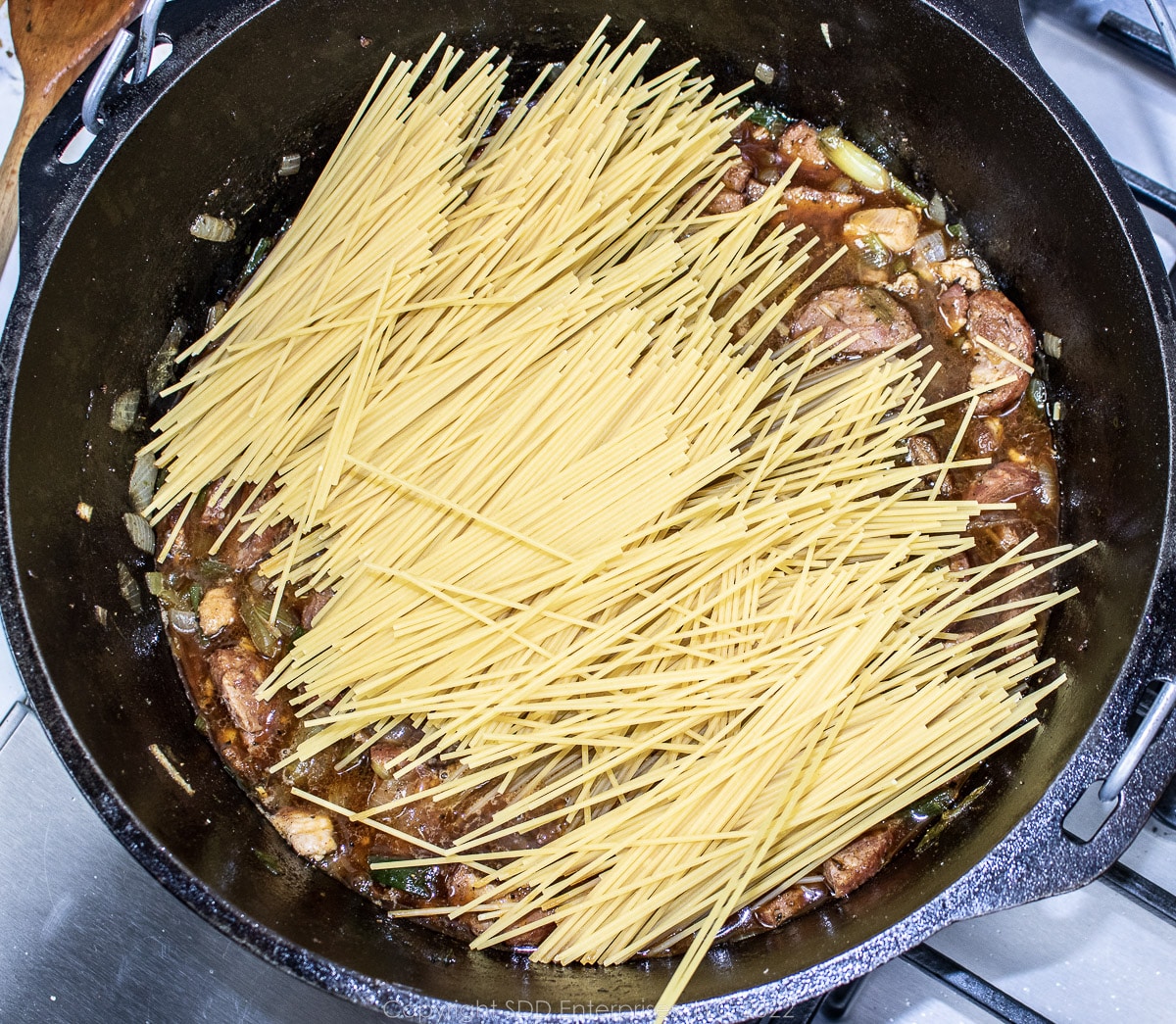
Pro Tip: You may not be able to get all the uncooked spaghetti into the stock. Gently push it down as best you can. The pasta will soften while it cooks, sinking down into the stock as it absorbs the liquid. and will mix well with everything else.
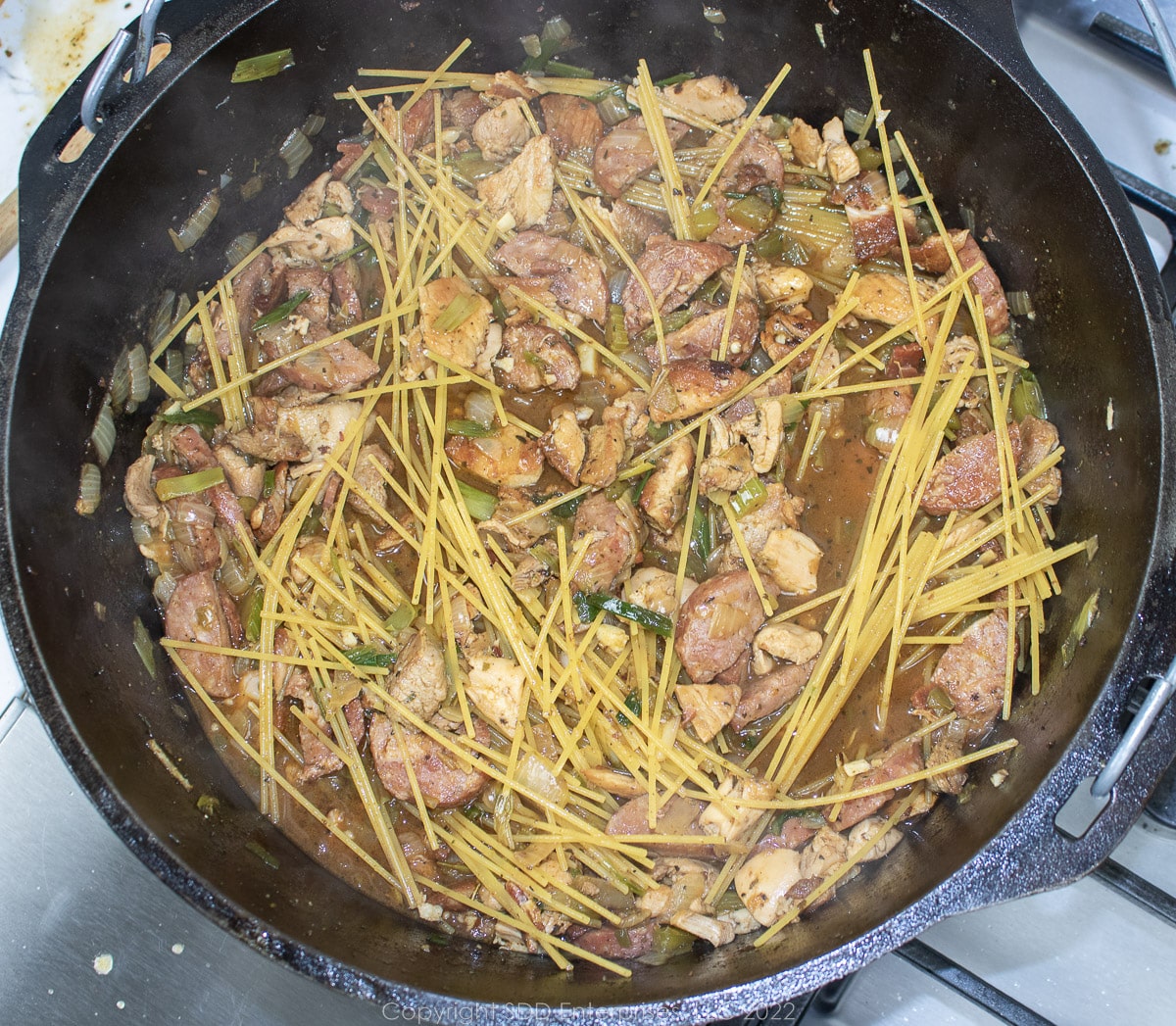
When the mixture returns to a slight boil, cover the Dutch oven and lower the heat. Simmer for 10 minutes, then remove the lid and stir thoroughly to mix all the pasta and other ingredients together.
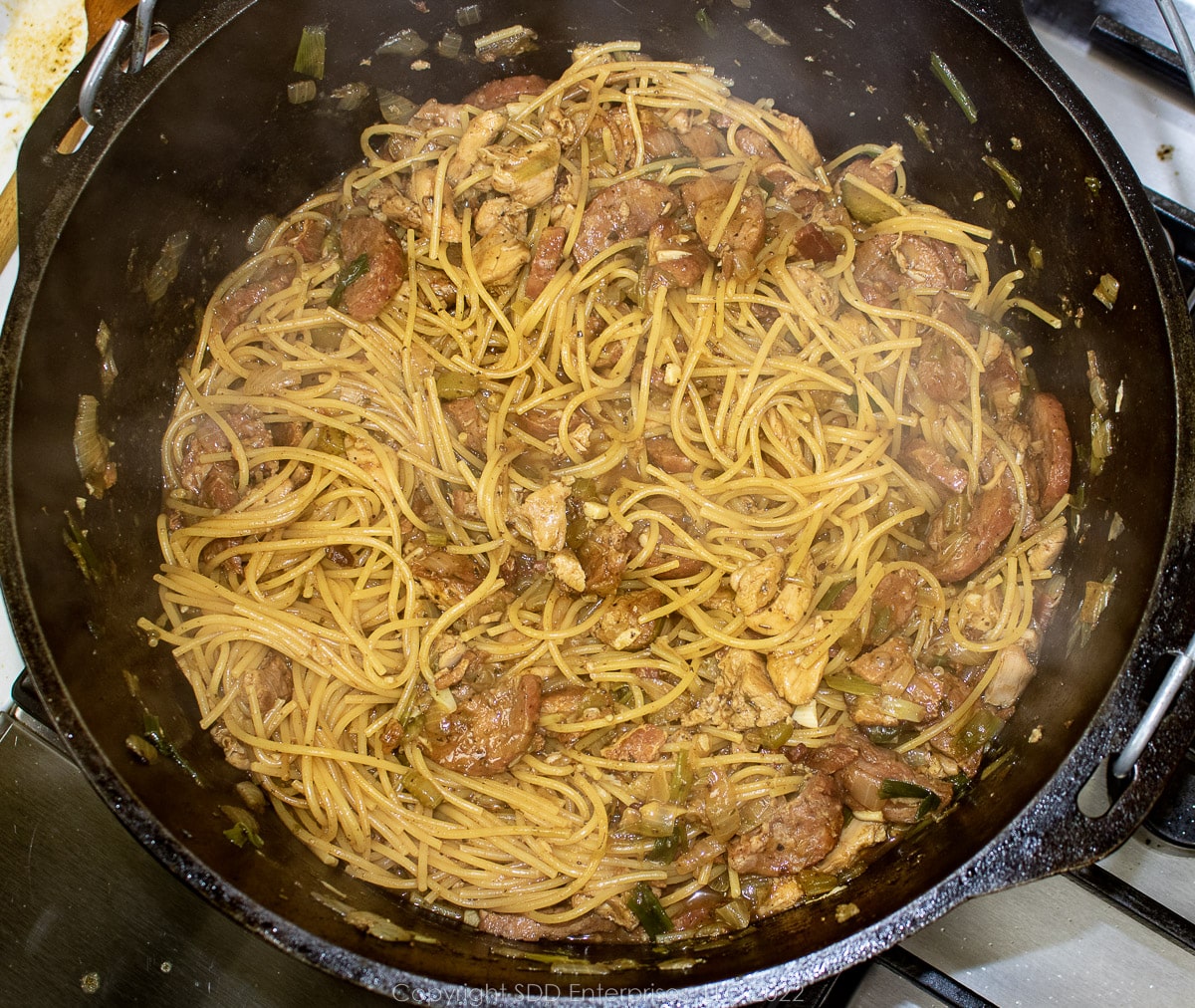
Place the cover back on the Dutch oven and simmer for another 10 minutes until the liquid is pretty much gone and the pasta is al dente. At this point, if there is a lot of liquid remaining or the pasta has not reached al dente, continue to simmer uncovered until the liquid is gone. Check every five minutes. If all the liquid is gone and the pasta has not reached al dente, just add a little more stock.
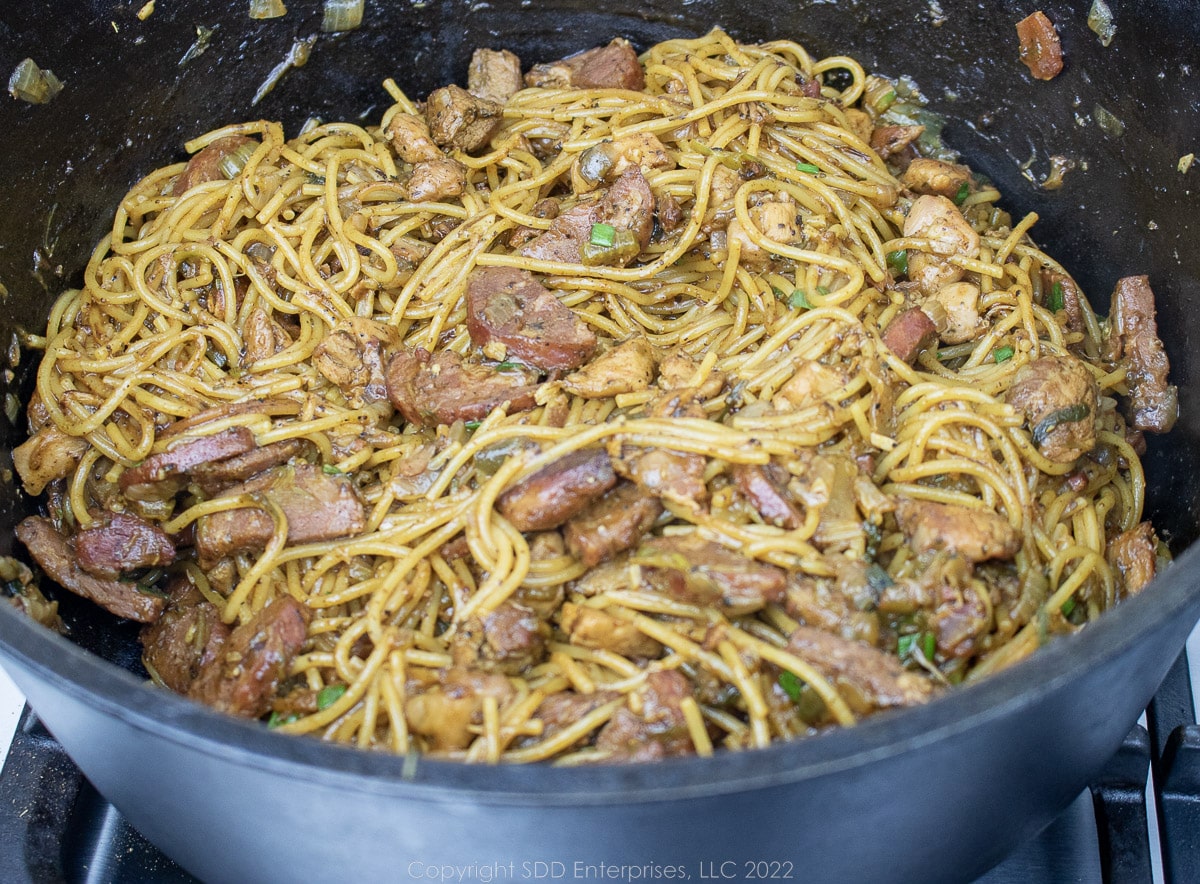
Hints and Tips (FAQs)
The ratio I use is 4 cups of liquid to 1 pound of spaghetti. In this recipe, I use an extra half-cup of stock to account for the reduction when the stock simmers uncovered before adding the spaghetti.
You can basically use whatever pasta you want, but I think spaghetti works best. Fettuccini and linguine are good substitutes. Hearty pasta like Bowtie and penne are popular substitutes as well. If you use something besides spaghetti, the cooking time may have to be adjusted to reach the al dente state.
You can use more or less of each of the meats or leave one or two of them out all together. Try to stick with the overall quantity for the meat, if possible. You can add shrimp in the last 10 minutes if you'd like. Personally, I would leave out the pork and chicken if I'm adding shrimp but it's all personal preference.
Vegetable stock or water can be substituted. If you decide to go with shrimp, shrimp stock is a great option.
Let the Pastalaya cool down before storing. Leftover Pastalaya can be refrigerated in an airtight container for 3 to 5 days. It can also be frozen in an airtight, freezer-safe container for about 3 months. A vacuum sealer works well. Thaw out overnight in the fridge. Reheat in the microwave or saucepan.
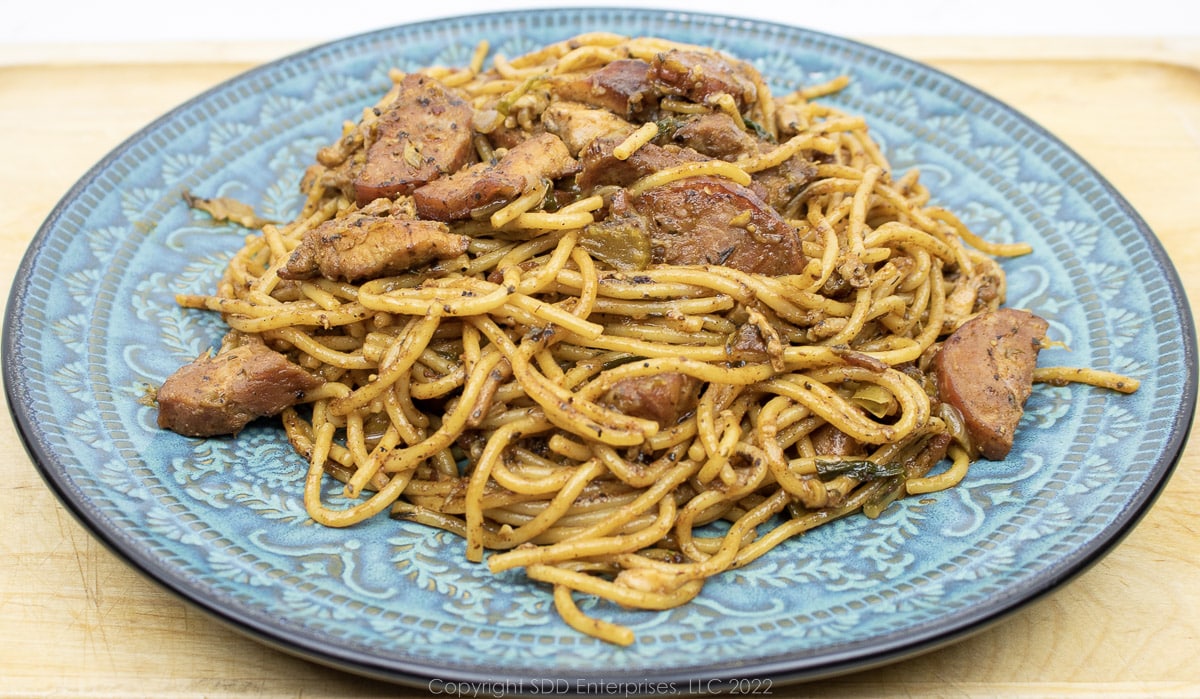
Try these side dishes with your Pastalaya:
In the mood for other "alayas"??
If you make this recipe:
- Tell us about it in the Comments section below
- LEAVE A RATING ON THE RECIPE-worthy of 5-Stars?
- Questions or Comments? that’s the place!
- SIGN UP FOR OUR EMAIL UPDATES so you don't miss anything!
- Post a picture and share it with your friends on our Social Media:
Yeah You Right!
Recipe
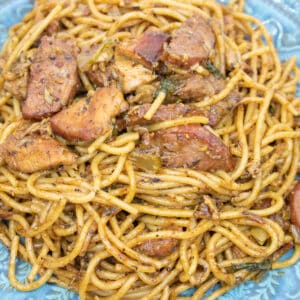
Pastalaya
Here's What You Need
- 3 slices bacon or 3 tablespoons bacon drippings
- ¾ pound pork butt cubes
- 1 pound smoked sausage
- ¾ pound chicken thighs
- 4 cups Yellow onions
- 1 cup Bell peppers
- ½ cup Celery
- 5 cloves Garlic
- 2 bunches Green onions
- 4 ½ cups Chicken Stock
- 1 pound dry spaghetti
Herb and Spice Blend
- 1 Tablespoon Creole seasoning
- ½ teaspoon kosher salt
- ½ teaspoon black pepper
Here's What You Do
- Fry slices bacon in a Dutch oven over medium heat until the fat has rendered, about 6 minutes.
- Add the pork and saute for about 12 to 15 minutes until starting to brown. Stir occasionally so that some searing takes place.
- Add the sausage and saute for about 15 minutes until browning and rendered.
- Add the chicken. Saute for about 10 minutes.
- Increase the heat to medium-high. Add the Trinity and mix well with the browned meats. Saute for about 15 minutes until browning. Stir occasionally.
- To the browned meats and Trinity (yellow onions, bell peppers, and celery) add the garlic, Creole seasoning, kosher salt, and black pepper. Mix well and saute for about 3 minutes until aromatic.
- Next, stir in about ¾ of the green onions, reserving the rest for later.
- Next, add 4 ½ cups of chicken stock. Start with about ½ cup of the stock and deglaze the Dutch oven. Combine the loosened fond in with the contents of the Dutch oven before adding the remainder of the stock. Bring to a slight boil. Reduce the heat and simmer for 10 minutes, uncovered.
- As the stock simmers, taste for seasoning and make adjustments as needed.
- After 10 minutes, increase the heat to a slight boil. Break the spaghetti in half and add it to the stock. Mix well, making sure to that all the pasta has touched the stock.
- Cover the Dutch oven and lower the heat. Simmer for 10 minutes, remove the lid and stir thoroughly to mix all the pasta and other ingredients together.
- Place the cover back on the Ducth oven and simmer for another 10 minutes. Check that al the liquid has been absorbed by the pasta. Test the pasta for al dente. If there is a lot of liquid or the past is not al dente yet, simmer another 5 minutes uncovered or until the liquid is gone.

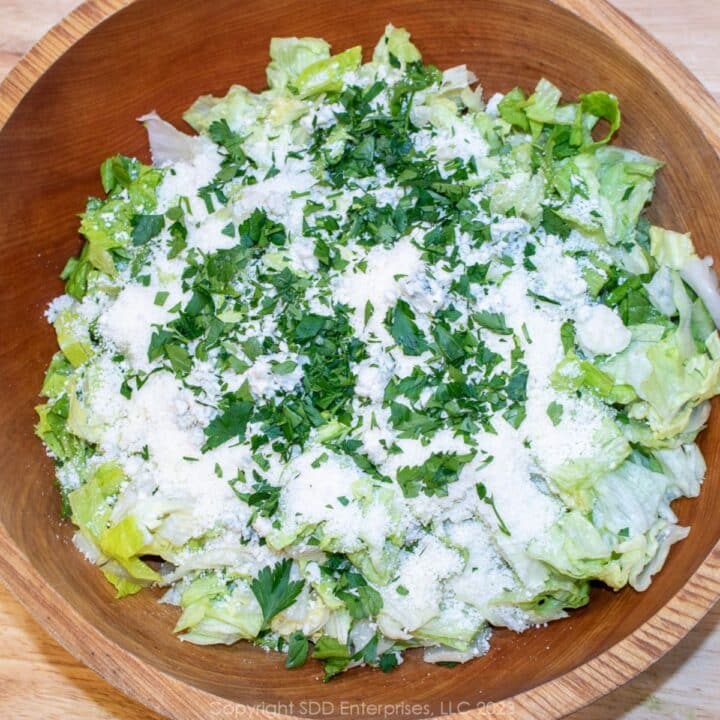
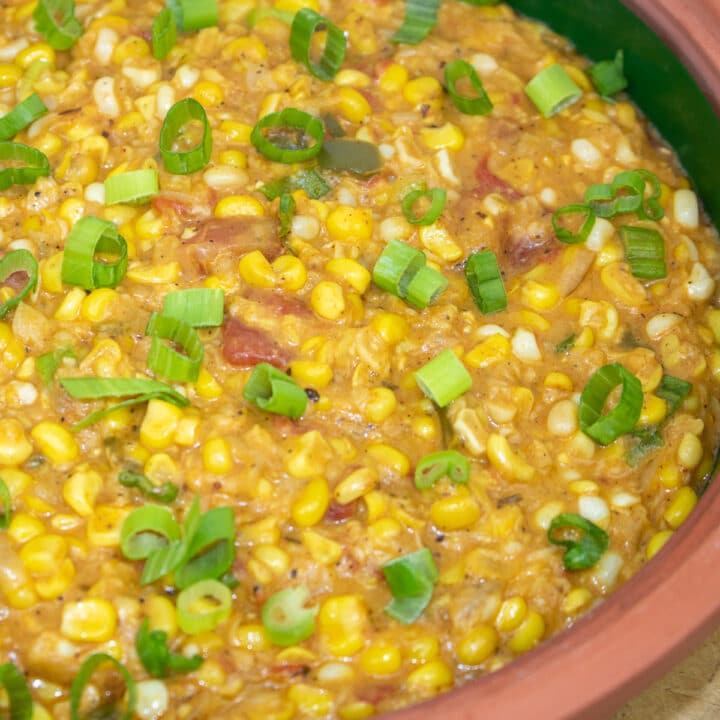
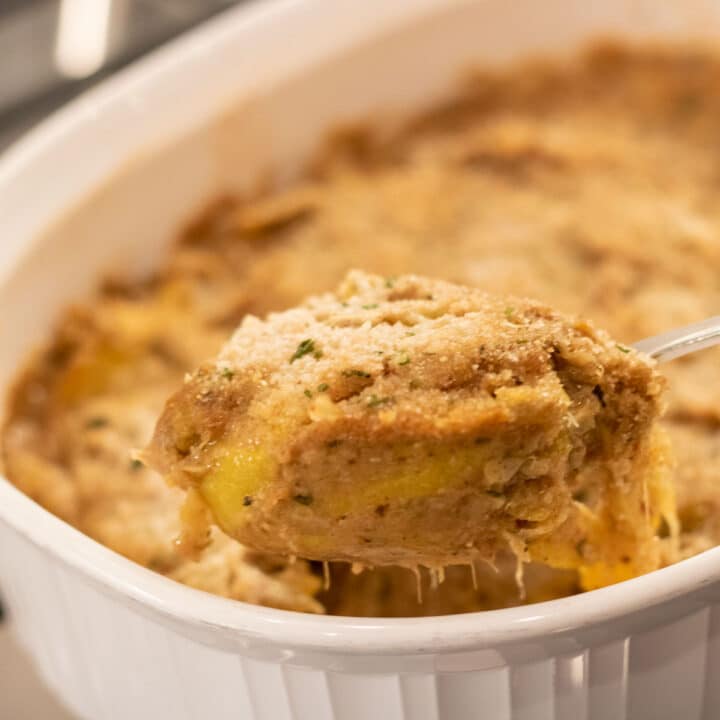
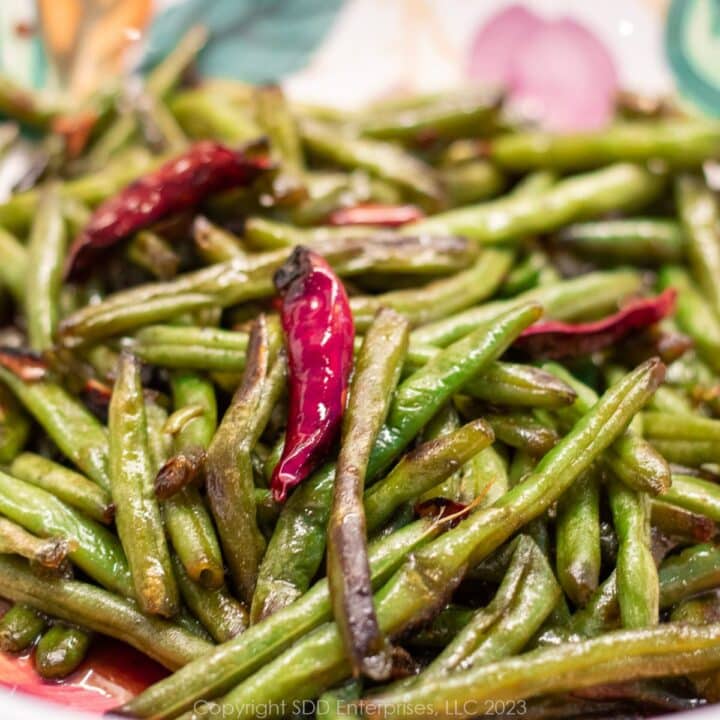
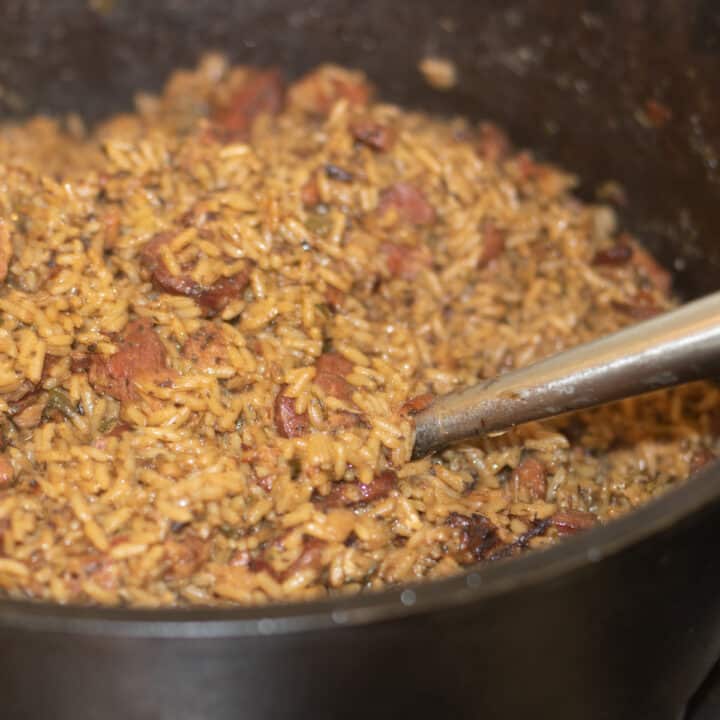
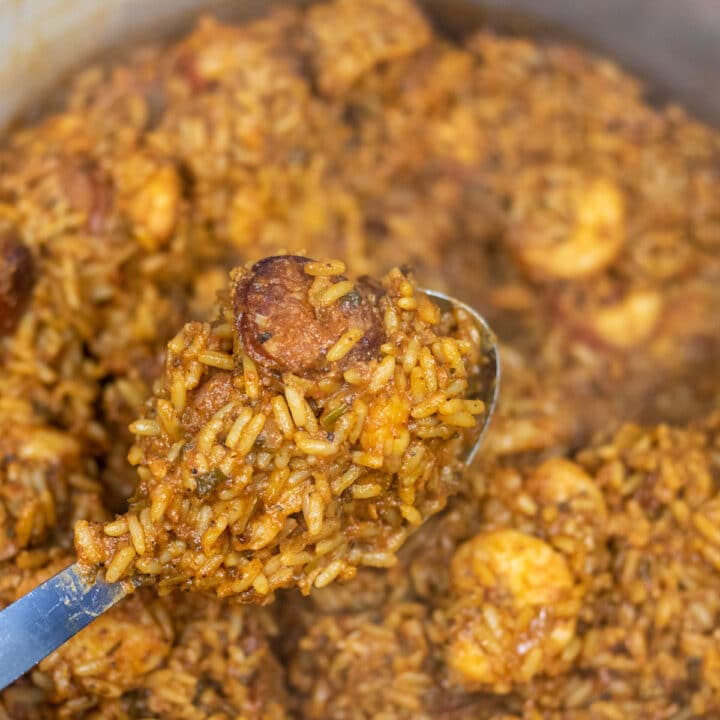
Happy Wife Happy Life
Sweet daddy d has turned me into a rockstar in the kitchen. Gives me so much confidence following one of your recipes, and the wife always loves it
Sweet Daddy D
Yeah you right, Dylan! Thanks for the comment. Gotta keep Mama happy! Keep cooking!
Chelsie
Heyy so you say Use a ratio of 4 cups of liquid for 1 pound of pasta but you use 4.5 cups of broth?
Sweet Daddy D
Hey, Chelsie. I can see where that may be a little confusing the way I wrote it. The basic ratio is 4 cups stock to 1 pound pasta. I add another 1/2 cup stock if the stock reduces too much as it simmers before adding the pasta. You can use 4 1/2 cups, just make sure it simmers uncovered for about 10 minutes to reduce before adding the pasta. When you let the stock reduce, it intensifies the flavor.
Chelsie
Perfect. Thanks!
Monai
So very good!
Sweet Daddy D
Thanks, Monai! Thanks for trying the recipe, I appreciate you taking the time to let me know. Glad you liked it!
MIKE
Awesome, love the recipe.
if like to add shrimp, how do I cook the shrimp with it?
Sweet Daddy D
Hey, Mike. Sounds good. I would season the shrimp with some Creole Seasoning (Le Bon Papa preferred!)and add them in the final 10 minutes of the cook. Let me know how it turns out.
Lauren
Was I supposed to take each meat out after browning? Pork and sausage ended up way over cooked 🫣
Sweet Daddy D
Hi Lauren, I do not remove the meats after they brown. This is the beginning of building the flavor and color we're looking for. The heat in the browning stage is medium because it does take a while to brown everything. Maybe you can cut the pieces a little larger to brown them. All that being said, it is an option to remove the meats after they are browned, then return them right before you add the pasta. I feel that you may miss out on some of the flavor you're building by doing that but when it's all done, I wonder if you'd even notice.
Nikki
I have always wanted to try making this but never found a recipe that sounded right. Well I have just found it!! Easy to follow and what wonderful flavors!
Sweet Daddy D
Yeah you right, Nikki! Thanks or giving the recipe a try and I appreciate you reaching out to me.
Brenda Rakestraw
What is the Trinity? Wasn’t mentioned in ingredients.
Sweet Daddy D
Hi, Brenda. The combination of the yellow onions, bell peppers, and celery are referred to as the Trinity (and sometimes the Holy Trinity) in Cajun and South Louisiana cooking. It serves the same purpose as mirepoix in French cuisine. Mirepoix is onions, celery, and carrots. In the article, I have a note describing the Trinity in the "Here's What You Need" section. Many recipes start with the Trinity to build a flavor base for the entire dish. Thanks for the question, I hope you try the Pastalaya recipe.